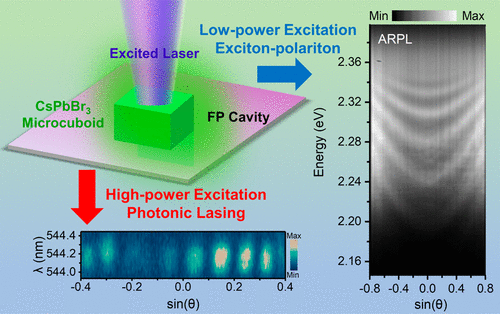当前位置:
X-MOL 学术
›
ACS Photonics
›
论文详情
Our official English website, www.x-mol.net, welcomes your
feedback! (Note: you will need to create a separate account there.)
Transition Between Exciton-Polariton and Coherent Photonic Lasing in All-Inorganic Perovskite Microcuboid
ACS Photonics ( IF 6.5 ) Pub Date : 2020-01-28 , DOI: 10.1021/acsphotonics.9b01413 Qi Han 1, 2 , Jun Wang 3 , Jian Lu 1, 2 , Liaoxin Sun 2, 4 , Feiyi Lyu 2, 5 , Hu Wang 1, 2, 5 , Zhanghai Chen 3 , Zhongyang Wang 1, 2
ACS Photonics ( IF 6.5 ) Pub Date : 2020-01-28 , DOI: 10.1021/acsphotonics.9b01413 Qi Han 1, 2 , Jun Wang 3 , Jian Lu 1, 2 , Liaoxin Sun 2, 4 , Feiyi Lyu 2, 5 , Hu Wang 1, 2, 5 , Zhanghai Chen 3 , Zhongyang Wang 1, 2
Affiliation

|
All-inorganic lead halide perovskites are ideal platforms to investigate the fundamental physics of the light–matter interactions, due to their strong oscillator strength at room temperature and various microstructures. In this paper, we investigated strong exciton-photon coupling and coherent photonic lasing in a same high-quality self-assembled CsPbBr3 perovskite microcuboid grown by a chemical vapor deposition method. The vacuum Rabi splitting of polariton up to 309 meV, and the exciton-like and photon-like components in low polariton states at different cavity-exciton detuning, were revealed by angle-resolved photoluminescence spectra at room temperature. Moreover, we realized a coherent photonic lasing with a high quality factor (4153) and narrow line width (0.13 nm) in the microcuboid above threshold (16 μJ/cm2), originated from population inversion. Significantly, the interference pattern of the coherent lasing through the Young’s double-slit interference method based on far-field Fourier optical system, directly indicate the parity (odd) of the lasing mode and the asymmetric electric-field distribution in the CsPbBr3 microstructure. Our work demonstrates for the first time a transition from the strong coupling regime (vertical Fabry–Pérot oscillation) to weak coupling regime (lateral Fabry–Pérot oscillation) in such self-assembled microcuboid under the competition between gain and internal loss. Based on this mechanism, a considerable promise is expected to enrich the functions of the micronanostructure photoelectric devices by precisely controlling the quality factor and gain of such microstructures.
中文翻译:

全无机钙钛矿微立方中激子-孤子和相干光子激光之间的过渡
全无机卤化铅钙钛矿是研究光与物质相互作用的基本物理学的理想平台,因为它们在室温下具有很强的振子强度,并且具有各种微观结构。在本文中,我们研究了在相同的高质量自组装CsPbBr 3中的强激子-光子耦合和相干光子激光。通过化学气相沉积法生长的钙钛矿微立方。通过室温下的角度分辨光致发光光谱揭示了高达309 meV的极化子的真空Rabi分裂,以及在不同腔激子失谐下处于低极化子态的激子状和光子状成分。此外,我们实现了一种高品质因数(4153)和高于阈值(16μJ/ cm 2)的微立方体中较窄的线宽(0.13 nm)的相干光子激光,其起源于种群反转。值得注意的是,通过基于远场傅里叶光学系统的杨氏双缝干涉法的相干激光的干涉图样,直接表明了CsPbBr 3中激光模式的奇偶性(奇数)和非对称电场分布微观结构。我们的工作首次证明了在增益和内部损耗之间的竞争下,在这种自组装微立方体中,从强耦合状态(垂直法布里-珀罗振荡)到弱耦合状态(横向法布里-珀罗振荡)的过渡。基于这种机理,通过精确地控制这种微结构的品质因数和增益,可以期望有很大的希望来丰富微纳米结构光电器件的功能。
更新日期:2020-01-29
中文翻译:

全无机钙钛矿微立方中激子-孤子和相干光子激光之间的过渡
全无机卤化铅钙钛矿是研究光与物质相互作用的基本物理学的理想平台,因为它们在室温下具有很强的振子强度,并且具有各种微观结构。在本文中,我们研究了在相同的高质量自组装CsPbBr 3中的强激子-光子耦合和相干光子激光。通过化学气相沉积法生长的钙钛矿微立方。通过室温下的角度分辨光致发光光谱揭示了高达309 meV的极化子的真空Rabi分裂,以及在不同腔激子失谐下处于低极化子态的激子状和光子状成分。此外,我们实现了一种高品质因数(4153)和高于阈值(16μJ/ cm 2)的微立方体中较窄的线宽(0.13 nm)的相干光子激光,其起源于种群反转。值得注意的是,通过基于远场傅里叶光学系统的杨氏双缝干涉法的相干激光的干涉图样,直接表明了CsPbBr 3中激光模式的奇偶性(奇数)和非对称电场分布微观结构。我们的工作首次证明了在增益和内部损耗之间的竞争下,在这种自组装微立方体中,从强耦合状态(垂直法布里-珀罗振荡)到弱耦合状态(横向法布里-珀罗振荡)的过渡。基于这种机理,通过精确地控制这种微结构的品质因数和增益,可以期望有很大的希望来丰富微纳米结构光电器件的功能。










































 京公网安备 11010802027423号
京公网安备 11010802027423号